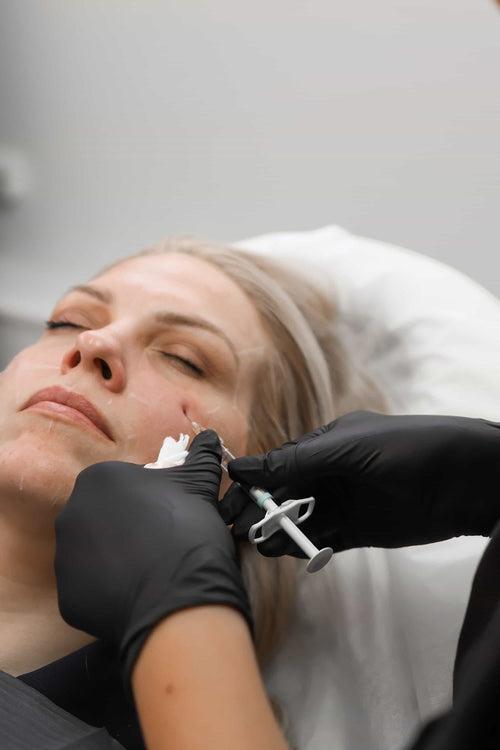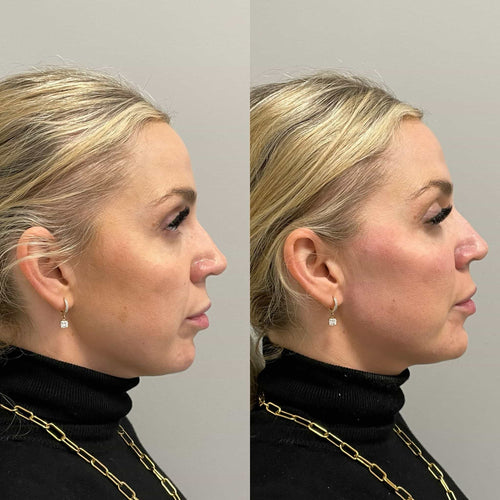Schedule Your Dermal Fillers with Dr. Laura Geige at It’s Me and You Clinic

Immediate Relief

Apply Ice
When lip fillers are first injected, it’s common to experience some discomfort and soreness.
Applying ice can help minimize this pain and reduce swelling by constricting blood vessels and slowing down inflammation.
Reserve Your Dermal Filler Consultation with Dr. Laura Geige
Here’s how to effectively use ice for immediate relief after lip filler injections:
1. **Gather your materials:** You’ll need a few things: an ice pack or bag of frozen peas, a clean cloth or towel, and possibly a cold compress specifically designed for facial use.
2. **Prepare the ice pack:** Wrap the ice pack or frozen peas in a thin cloth or towel to prevent direct contact with your skin, which could cause irritation or frostbite.
3. **Apply gently to the area:** Position the wrapped ice pack on the treated lips for 10-15 minutes at a time, avoiding prolonged contact that could damage the skin.
4. **Take breaks:** Remove the ice pack and allow your skin to warm up for a few minutes before reapplying. You can repeat this process several times throughout the day as needed.
5. **Combine with other methods:** For added relief, consider combining ice application with over-the-counter pain relievers such as ibuprofen or acetaminophen as directed by your doctor.
Over-the-Counter Pain Relievers
Lip filler treatments are becoming increasingly popular, but they often come with some discomfort. Pain can range from a mild stinging sensation to more intense throbbing, especially after the procedure. While temporary, this pain can be bothersome and impact your comfort for a few days.
Fortunately, over-the-counter (OTC) pain relievers are readily available and effective in managing lip filler discomfort. These medications work by reducing inflammation and blocking pain signals to the brain.
Ibuprofen and Naproxen are nonsteroidal anti-inflammatory drugs (NSAIDs) that effectively reduce pain and swelling associated with lip fillers. Take them as directed on the label, usually every four to six hours as needed.
Acetaminophen is another popular OTC pain reliever that targets pain without reducing inflammation. It can be helpful in managing mild to moderate pain from lip fillers.
Always read and follow the dosage instructions on the medication label. If you experience persistent or severe pain, consult your doctor immediately.
While OTC pain relievers can provide relief, they are not a substitute for proper post-treatment care provided by your injector. Following their instructions carefully, including applying ice packs and avoiding certain activities, is crucial for optimal healing and minimizing discomfort.
Preventative Measures
Choose a Reputable Injector
When considering lip filler injections, preventative measures are crucial to minimize pain and ensure a comfortable experience.
Choosing a reputable injector is paramount. Look for a licensed professional with extensive experience in dermal fillers specifically.
Experience matters. A skilled injector will possess a deep understanding of facial anatomy and the appropriate techniques to administer filler safely and effectively.
Don’t hesitate to ask about their qualifications, training, and track record. Review online reviews and testimonials from previous patients to gauge their expertise and reputation.
A reputable injector will prioritize your comfort and safety.
They will thoroughly discuss your desired outcome, medical history, and any concerns you may have.
Moreover, they will explain the procedure in detail, outlining potential risks and side effects.
Don’t be afraid to ask questions and ensure you feel confident and informed before proceeding with the treatment.
Discuss Your Medical History
Preventive measures are crucial when considering lip filler injections to minimize discomfort and potential complications.
One of the most important steps is choosing a qualified and experienced injector. Look for a licensed medical professional with extensive training and experience in administering dermal fillers, ideally specializing in facial aesthetics.
Discuss your medical history thoroughly with your chosen injector. This includes any allergies, current medications, past cosmetic procedures, and any bleeding disorders you may have. Certain medications like blood thinners can increase the risk of bruising or swelling after injections.
Avoid taking aspirin, ibuprofen, or other blood-thinning medications for a few days leading up to your appointment. These medications can interfere with the clotting process and increase the likelihood of bleeding or bruising.
On the day of your appointment, avoid consuming alcohol as it can also thin the blood.
Ensure you are well-hydrated by drinking plenty of water in the days leading up to the procedure. Proper hydration helps with tissue health and can minimize swelling after injections.
Communicate openly with your injector about your pain tolerance and any concerns you have. They may recommend numbing creams or topical anesthetics to be applied prior to the injections, which can significantly reduce discomfort.
It’s also important to understand the potential risks and complications associated with lip fillers. While generally considered safe when performed by a qualified professional, there is always a possibility of bruising, swelling, infection, or allergic reactions. Discuss these risks with your injector beforehand so you are fully informed.
Follow Aftercare Instructions Carefully
Preventing pain after lip filler injections involves a proactive approach both before and after the procedure. Choosing a qualified and experienced injector is paramount. A skilled practitioner will understand facial anatomy, injection techniques, and proper product selection to minimize discomfort.
Prior to your appointment, consider discussing any anxieties or past experiences with pain management with your injector. They may recommend over-the-counter pain relievers like ibuprofen or acetaminophen an hour or two beforehand.
On the day of the procedure, avoid caffeine and alcohol as they can increase sensitivity. Arrive well-rested and hydrated for optimal healing.
Following aftercare instructions diligently is crucial to reduce post-injection pain and swelling. Typically, this involves applying ice packs to minimize inflammation and avoiding strenuous activity that could increase blood flow to the area.
Gentle massage as directed by your injector can help distribute the filler evenly and reduce lumps or bumps, minimizing discomfort.
Staying hydrated is essential for tissue healing and reducing any potential dryness or irritation. Avoid touching or picking at your lips as this can introduce bacteria and delay healing.
Adhering to a healthy diet rich in vitamins and antioxidants supports overall healing and skin health. If you experience persistent pain or swelling, contact your injector immediately for guidance.
When to Seek Professional Help
Persistent Swelling or Discomfort
Persistent swelling or discomfort after lip filler treatment can be concerning, and it’s important to know when seeking professional medical help is necessary.
Here are some signs that you should reach out to your injector or a healthcare professional:
-
Swelling that lasts longer than two weeks.
-
Increasing pain or discomfort beyond the initial expected soreness.
-
Signs of infection, such as redness, warmth, pus, or fever.
-
Numbness or tingling that doesn’t subside after a few days.
-
Uneven or asymmetrical lips.
-
Hard lumps or bumps in the treated area that don’t seem to soften over time.
While some mild swelling and tenderness are normal after lip filler injections, these symptoms should gradually subside within a few days. If you experience any of the above issues, it’s important to seek professional help promptly to address potential complications and ensure proper healing.
Signs of Infection
Lip filler injections can temporarily cause discomfort, swelling, and bruising, which typically subside within a few days.
However, if you experience any concerning symptoms or your pain persists beyond a reasonable timeframe, it’s crucial to seek professional help from a medical practitioner, preferably the one who administered the treatment.
Here are some signs that warrant immediate medical attention:
• Intense and persistent pain that worsens over time instead of improving
• Significant swelling that doesn’t subside after several days or spreads to other areas
• Fever, chills, or other signs of infection such as redness, warmth, or pus around the injection site
• Numbness or tingling sensations that last longer than a few days
• Difficulty breathing or swallowing
• Vision changes or headaches
• Allergic reaction symptoms like hives, itching, or difficulty breathing
It’s essential to remember that these are potential signs of complications, and seeking medical attention promptly can help prevent further issues.
If you notice any of these symptoms, contact your doctor immediately. Delaying treatment could potentially lead to serious health consequences.
Remember, it is always better to err on the side of caution when it comes to your health.
Unexpected Allergic Reactions
Unexpected allergic reactions to lip filler can be serious and require immediate medical attention. It’s crucial to know when to seek professional help in such situations.
Here are some signs that you need to see a doctor right away after receiving lip filler:
**Difficulty breathing or swallowing:** This could indicate swelling that is obstructing your airway, a life-threatening condition.
**Hives or widespread rash:** A severe allergic reaction can cause hives to appear all over the body. A sudden onset of a large itchy rash is also a warning sign.
**Swelling beyond the lips:** If swelling spreads to your face, neck, or throat, it’s important to seek medical attention as this could indicate anaphylaxis.
**Extreme itching or burning:** While some mild discomfort is normal after lip filler treatment, intense itching and burning that doesn’t subside can be a sign of an allergic reaction.
**Nausea or vomiting:** These symptoms might accompany an allergic reaction. If you experience them alongside other signs, it’s crucial to seek medical help.
** Dizziness or lightheadedness:** These sensations could be related to anaphylaxis or a drop in blood pressure.
If you notice any of these symptoms, call emergency services immediately.
Even if your symptoms seem minor, it’s always best to err on the side of caution and contact your doctor or a medical professional. They can assess the situation, provide appropriate treatment, and help prevent potential complications.
Raindrops and Ribbons Emri Studio Kurious Kittens
- How Long Lip Filler Settle - August 15, 2025
- How Long Does It Take For CBD Capsules To Work? - August 10, 2025
- How Long Do Nasolabial Fillers Last? - August 8, 2025
